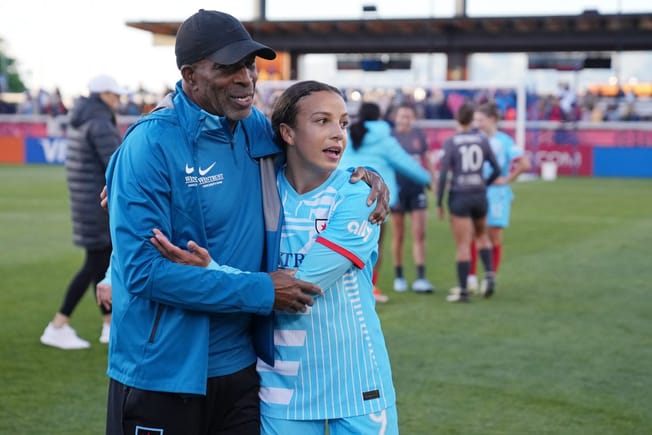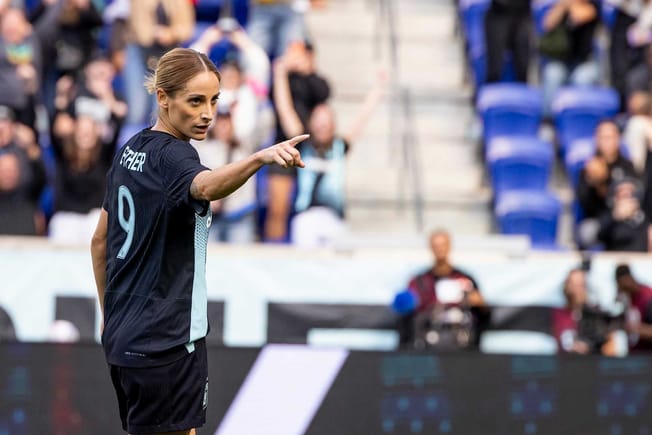While most teams in the NWSL have moved on from the preseason and turned their focus to the 2022 regular season, two teams have their eyes on the Challenge Cup title: the North Carolina Courage and the Washington Spirit will face off in the final on Saturday, May 7th. We’re not quite ready to leave the Challenge Cup behind, either.
The Challenge Cup’s group stage, which was split into three regional groups of four teams each, lived up to the tournament’s ‘CueTheChaos’ hashtag.
What have we learned from the Challenge Cup so far? Let’s dive in.
All statistics reflect group stage play.
NORTH CAROLINA EXCEEDS EXPECTATIONS
North Carolina’s success in the Challenge Cup came as a shock because of the uncertainty that surrounded the squad heading into the tournament. Their offseason was headlined by a number of trades (Jessica McDonald, Sam Mewis, and Lynn Williams), a quiet retirement (Amy Rodriguez), international signings (Kerolin Nicoli, Valérie Gauvin, and Katie Bowen), and five rookie contracts (Emily Gray, Diana Ordoñez, Kaitlin Fregulia, Haleigh Stackpole, and Marisa Bova).
With all of those moves, many expected this season to be a rebuilding year. But if the team’s performance in the Challenge Cup is any indication, head coach Sean Nahas was onto something when he insisted the team was “evolving” instead of rebuilding.
The Courage’s dominant group stage performances earned them the East Region title and their win over the Kansas City Current in the semifinals has them through to the final. North Carolina’s game has traditionally involved high pressing and fast transitions, and despite all of their roster turnover and the fact that the Challenge Cup is still technically preseason, it seems like players have already bought-in and employed these tactics successfully.
On a player level, Debinha was brilliant in the midfield in the group stage, leading the Courage in shots, shots on target, and goals. She scored four of the Courage’s 12 goals throughout the group stage, which is already one more than the three goals she scored in the 2021 regular season (across 18 games). The arrival of Kerolin Nicoli made North Carolina’s attack even more dangerous. In just over 150 minutes across three games, she recorded 11 shots with three on target. As she continues to settle into her new role with the Courage, Kerolin will be a problem for NWSL backlines.
Finally, it’s worth mentioning that the Courage found this success without Casey Murphy, their starting goalkeeper, on the pitch. Katelyn Rowland stepped in and faced 17 shots while conceding seven goals, which translates into a 2.4 shots/goal rate. Compare that to Murphy’s 23 goals conceded on 119 shots (5.2 shots/goal) in her 2021 campaign, and it becomes exceedingly clear that Murphy’s return will tighten things up in North Carolina’s defensive third and make them even more of a threat.
KANSAS CITY’S NEWFOUND SUCCESS
The Kansas City Current had a disappointing 2021 season, earning just three wins across 24 games. Despite this, both reporters and fans seemed optimistic about Kansas City’s outlook for 2022. This outlook could be chalked up, in part, to the signing of USWNT players Sam Mewis and Lynn Williams in the offseason. Mewis and Williams were expected to link up with their former North Carolina teammates in Hailie Mace and Kristen Hamilton and wreak havoc in the Central Region. However, Williams suffered a season-ending injury 83 minutes into the Challenge Cup, Mewis was limited to just 94 minutes over the first two group-stage games, and Hailie Mace found herself on the injury report after just four games.
Adversity aside, the Current still came out on top, tying OL Reign for most wins across all teams with four and securing a home semifinal match.
In addition to veteran striker Hamilton and her four goals, Kansas City can attribute much of their success to their rookie class. In fact, their back-line was anchored by newcomers in Alex Loera and Jenna Winebrenner, both of whom put on an impressive showing through six games: Kansas City kept their opponents to the second-fewest shots, only behind reigning NWSL Champions Washington Spirit. Loera also opened her scoring account with a SportsCenter Top 10-worthy banger.
Elyse Bennett also stepped in following Williams’ injury and ended up leading the Challenge Cup in group stage assists with four.
Can you imagine what will happen once Mewis and Mace get healthy and reintegrate into the Current’s starting lineup? If the Challenge Cup holds any weight for Kansas City, they might just sneak into the playoffs this season.
GOTHAM’S QUESTIONABLE START
While the Current met – and exceeded – expectations, NJ/NY Gotham FC had a rocky Challenge Cup. The team posted one win, three draws, and two losses during the tournament and ultimately recorded a -3 goal differential after allowing eight goals and scoring five, with just two goals in open-play.
Gotham’s inability to put together cohesive, 90-minute performances in the Challenge Cup doesn’t make much sense on paper. They returned the core of their back-line in Gina Lewandowski, Estelle Johnson, Imani Dorsey, and 2021 NWSL Defender of the Year Caprice Dydasco. On the other end of the pitch, Gotham is (finally) leveraging a healthy Paige Monaghan alongside players like Ifeoma Onumanu and Margaret Purce. And, if anything, you could argue that the acquisition of players like Kristie Mewis, Ali Krieger, and Ashlyn Harris should have made the 2022 edition of the team even better.
Instead, Gotham’s play has dropped off.
This could be due to the absences of goalkeeper Kailen Sheridan (traded to San Diego Wave FC) and midfielder Allie Long (maternity leave). Sheridan was impressive last season, often securing points for a team that struggled to get on the scoreboard. Before leaving for San Diego, she had been a mainstay in the NJ/NY defense since 2017. Unfortunately for Gotham, neither Harris nor Michelle Betos are like-for-like replacements for the Canadian keeper.
Long commanded the center of the pitch with captain McCall Zerboni in 2021, seamlessly bridging the gap between the backline and forwards. Without her, Gotham is clearly still searching for their midfield’s identity: they slotted in four different combinations of players across their six Challenge Cup games. Maybe it just took longer than expected for this Gotham squad to work out the kinks – they did win their first game of the regular season, after all.
Speaking of the regular season, now that it’s underway it will be interesting to see how these teams look against more opponents outside of their Challenge Cup regions. It’s hard to predict whether North Carolina and Kansas City will continue to find success or if Gotham will continue on this downward trajectory. If we know anything, though, it’s that the chaos will continue past the Challenge Cup and into the NWSL regular season.







Comments